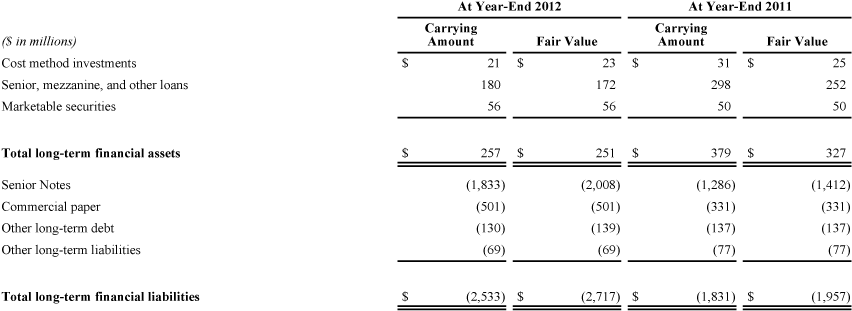Financial Information
4. FAIR VALUE OF FINANCIAL INSTRUMENTS
We believe that the fair values of our current assets and current liabilities approximate their reported carrying amounts. We show the carrying values and the fair values of noncurrent financial assets and liabilities that qualify as financial instruments, determined under current guidance for disclosures on the fair value of financial instruments, in the following table:

We estimate the fair value of our senior, mezzanine, and other loans, including the current portion, by discounting cash flows using risk-adjusted rates, both of which are Level 3 inputs.
We estimate the fair value of our cost method investments by applying a cap rate to stabilized earnings (a market approach using Level 3 inputs). During the third quarter of 2012, we determined that a cost method investment was other-than-temporarily impaired and, accordingly, we recorded the investment at its fair value as of the end of the 2012 third quarter ($12 million) and reflected a $7 million loss in the “Gains (losses) and other income” caption of our Income Statement. We estimated the fair value of the investment using cash flow projections discounted at risk premiums commensurate with market conditions. We used Level 3 inputs for these discounted cash flow analyses and our assumptions included revenue forecasts, cash flow projections, and timing of the sale of each hotel in the underlying investment.
We are required to carry our marketable securities at fair value. We value these securities using directly observable Level 1 inputs. The carrying value of our marketable securities at year-end 2012 was $56 million, which included debt securities of the U.S. Government, its sponsored agencies and other U.S. corporations invested for our self-insurance programs as well as shares of a publicly traded company. During the third quarter of 2011, we determined that the shares of a publicly traded company that we held were other-than-temporarily impaired and, accordingly, at the end of the 2011 third quarter we recognized an $18 million loss which we reflected in the “Gains (losses) and other income” caption of our Income Statement. This loss included $10 million of losses that had been recorded in other comprehensive income as of the end of the 2011 second quarter, which we also included in the “Reclassification of losses” caption of our Consolidated Statements of Comprehensive Income in 2011.
We estimate the fair value of our other long-term debt, including the current portion and excluding leases, using expected future payments discounted at risk-adjusted rates, both of which are Level 3 inputs. We determine the fair value of our senior notes using quoted market prices, which are directly observable Level 1 inputs. As noted in Footnote No. 11, “Long-term Debt,” even though our commercial paper borrowings generally have short-term maturities of 30 days or less, we classify outstanding commercial paper borrowings as long-term based on our ability and intent to refinance them on a long-term basis. As we are a frequent issuer of commercial paper, we use pricing from recent transactions as Level 2 inputs in estimating fair value. At year-end 2012 and 2011, we determined that the carrying value of our commercial paper approximated its fair value due to the short maturity. Our other long-term liabilities primarily consist of guarantee costs. As noted in Footnote No. 14, “Contingencies,” we measure our liability for guarantees at fair value on a nonrecurring basis, that is when we issue the guarantee or when an existing guarantee is modified, using Level 3 internally developed inputs. At year-end 2012 and 2011, we determined that the carrying values of our guarantee costs approximated their fair values based on Level 3 inputs.
We estimate that the fair values of our letters of credit and surety bonds are the same as their contract values based on the nature of the fee arrangements with the issuing financial institutions. See Footnote No. 14, “Contingencies” for the related balances.
See the “Fair Value Measurements” caption of Footnote No. 1, “Summary of Significant Accounting Policies” for more information on the input levels we use in determining fair value.
See Footnote No. 16, “Spin-off” for more information on the $324 million ($234 million after-tax) of Timeshare strategy-impairment charges recorded in 2011 to write down the carrying amounts of inventory and property and equipment to their respective fair values.
